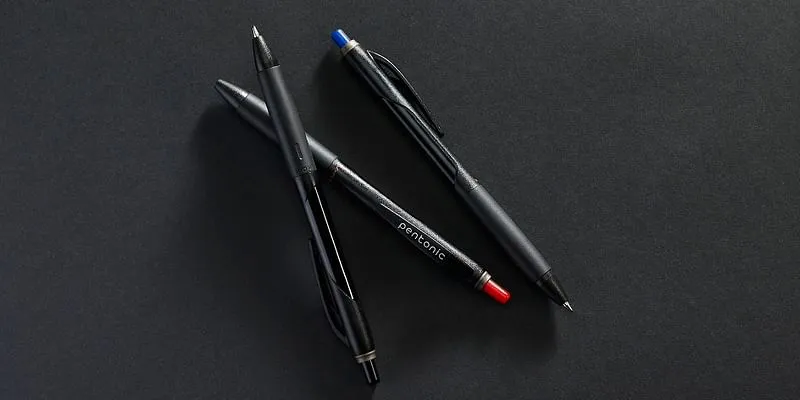How Linc wrote its success story with a Rs 5 gel pen
Kolkata-based Linc Pen & Plastics Managing Director Deepak Jalan talks about why his father founded the company, how innovation has kept it viable for 45 years, and enabled it to clock a turnover of Rs 400 crore.
Do we need pens any more?
Ask Deepak Jalan this question and pat comes the reply: “No matter how much we digitalise, pen and paper will never go out of fashion.”
A second generation entrepreneur, Deepak is the managing director of Ltd, a Kolkata-based company making ballpoint pens since 1976. It also manufactures an array of stationery items including markers, geometry boxes, pencils, and erasers.
The company was founded by Deepak’s father, Suraj Mal Jalan, who moved from Rajasthan to Kolkata in the 1960s to pursue a college degree. Suraj Mal also had entrepreneurial ambitions and was looking for ideas.
As a college student, pens were an indispensable part of his life. But there weren’t too many options back then except fountain pens and ballpoint pens.
Fountain pens, though expensive, often leaked ink and were thus messy to use, while good ballpoint pens priced around Rs 10 were also quite costly. Suraj Mal wanted to make affordable pens.
“When my father decided to start the business, there was a brand called Wilson Pen (fountain pen maker) that people longed for,” says Deepak. “As its pens were expensive, not many could buy them. This made my father think of starting a ballpoint pen company.”
As Linc steps into its 45th year, it has clocked a turnover of Rs 400 crore in FY20 and is a listed company. Its products are available in 1.5 lakh retail stores throughout the country, while exports reach 40 countries. Subsidiary brands Bensia, Deli, Pentonic, Markline, and others also have a market presence.
What makes a good pen?
The quality of a pen depends on its metal tip and the ink, says Deepak. In the 1960-70s, India lacked both.
“There was a dearth of these quality materials, so not many companies were making good pens,” he says. “My father partnered with two friends, who were working in the pen industry at that time, imported the metal tip from Switzerland and the ink from Germany, and began manufacturing ball pens.”
Suraj Mal invested a few thousand rupees of his savings and launched the first Linc ball pen for Rs 2 from a small manufacturing facility in Kolkata.
Gradually, Linc’s range of pens grew to a handful and they were available across West Bengal.

Linc Pen's Pentonic range
Gelling well with the market
Deepak joined the business in the early 1980s, when he was 18. In 1986, he set up a full-fledged manufacturing unit. Linc launched its initial public offering (IPO) in 1995 to have more financial resources that would allow it to take risks.
“Soon after launching the IPO, we began export of our ball pens and entered South Korea,” he says. “This was also the time when gel pens started becoming popular in India.”
Schools usually encourage students to write with water-based fountain ink pens, rather than ball pens, which use oil-based ink. As fountain pens were messy to use, Suraj Mal and his son decided to make gel pens, which also used water-based ink.
In 2002, Linc launched its gel pen range, High School Pens, when Add Pens was the leader in the category. While the gel pens of competitors were priced at Rs 20 and above, those of Linc, with ink imported from Japan, cost Rs 10, says Deepak.
Even as Linc had widened its reach to the northern, eastern, and western parts of India by then, the father-son pair sought to deepen its market by making the pens available in semi-rural and rural areas.
So they launched the Linc Ocean Gel Pen at Rs 5, which, according to Deepak, was the first gel pen to be sold at such a low price.
There were other unexpected dividends of this move.
“We launched the Linc Ocean Gel Pen to go deeper into the market, but to our surprise, it became our biggest hit,” says Deepak. “Our survey showed that one out of every three students, not only in rural and semi-rural areas, but also in cities, was using this pen.”
It was after the launch of this low-priced gel pen that Linc became a prominent brand. Now, it manufactures 50 products at its facilities in Kolkata and Umbergaon in Gujarat, and has more than 250 stock-keeping units.
Innovation is the byword
The need to offer the best quality products at competitive prices is one of the biggest challenges, says Deepak. Add to that the perception that Linc is a mass market brand despite making high quality products, he says.
The company has been trying to develop products that would help insulate its margins from polymer price volatility and secure the top line and bottom line, but the managing director says it is a tough task.
“The entry barrier is very low in the pen industry and this gives rise to unorganised players, leading to unnecessary competition,” he says. “But we have drawn a line that we would not go below the Rs 5 price point, as it isn’t feasible for an organised company to do so.”
According to Deepak, Linc has a market share of 10 percent in the Indian writing instrument market. Cello, Lexi, and Reynolds have a major share in this market, while Flair, Rotomac, Stic, Luxor, and Montex are other recognised brands, says a 2014 study in the Business and Economics Journal.
Another challenge is distinguishing the company from others in the industry. For this continuous innovation is key, says Deepak.
“Recently, we launched our brand, Pentonic, to give users a new feel of a pen. We launched this pen to attract professionals. We made it sleek and long, with a body black in colour in order to give it a different appearance from other pens. But we were surprised to see that besides our target segment, school students liked it a lot and demand for these pens grew.”

Linc's Pentonic B-RT pen
Demand prospects
As schools and colleges shut due to the COVID-19 pandemic last year, it dealt a blow to the stationery industry in India. Simultaneously, the phenomenal rise of edtech meant students were learning at home with the help of the screen and had less need for pens and stationery.
Like other stationery brands, Linc was hit. However, there has been a gradual pick-up in demand, says Deepak.
“Demand washed out in April and May 2020 due to COVID-19, but for FY21 we are expecting to cover around 65 percent of the last calendar year’s sales figures,” he says. “Since August, we are clocking 75 percent of the last calendar year’s sales.”
He remains optimistic about the future of pens and the industry.
“Great things happen when you put pen to paper,” he says. “School and college students, who are our core target group, will always need a writing instrument in their educational journey. Even executives, our secondary target group, would need pens to take notes or put their signature.”
In the near term, the company plans to extend Pentonic’s range to gel ink pens.
Edited by Lena Saha









![[World Heritage Day] 10 Indian SMBs preserving the nation's traditional handicrafts and artisans](https://images.yourstory.com/cs/21/98e25df018b511e988ceff9061f4e5e7/collage4-1618638355762.png?mode=crop&crop=faces&ar=1%3A1&format=auto&w=1920&q=75)